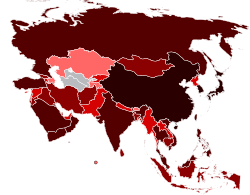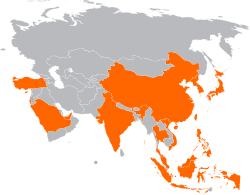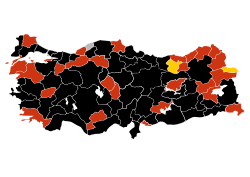| 2009 | A(H1N1) Outbreak and Pandemic Milestones in Asia |
|---|
| 28 April |  First case confirmed in Israel. First case confirmed in Israel. |
| 1 May |  First case confirmed in Hong Kong. First case confirmed in Hong Kong. |
| 2 May |  First case confirmed in South Korea. First case confirmed in South Korea. |
| 8 May |  First case confirmed in Japan. First case confirmed in Japan. |
| 10 May |  First case confirmed in China. First case confirmed in China. |
| 12 May |  First case confirmed in Thailand. First case confirmed in Thailand. |
| 15 May |  First case confirmed in Malaysia. First case confirmed in Malaysia. |
| 16 May |  First case confirmed in India. First case confirmed in India. |
| 16 May |  First case confirmed in Turkey. First case confirmed in Turkey. |
| 17 May |  Community outbreaks confirmed in Japan. Community outbreaks confirmed in Japan. |
| 19 May |  First case confirmed in Taiwan. First case confirmed in Taiwan. |
| 21 May |  First case confirmed in the Philippines. First case confirmed in the Philippines. |
| 22 May |  First case confirmed in Russia. First case confirmed in Russia. |
| 24 May |  First case confirmed in Kuwait. First case confirmed in Kuwait. |
 First case confirmed in the United Arab Emirates. First case confirmed in the United Arab Emirates. |
| 25 May |  First case confirmed in Bahrain. First case confirmed in Bahrain. |
| 27 May |  First case confirmed in Singapore. First case confirmed in Singapore. |
| 30 May |  First case confirmed in Cyprus. First case confirmed in Cyprus. |
 First case confirmed in Lebanon. First case confirmed in Lebanon. |
| 31 May |  First case confirmed in Vietnam. First case confirmed in Vietnam. |
| 3 June |  First case confirmed in Saudi Arabia. First case confirmed in Saudi Arabia. |
| 11 June |  First case confirmed in the Palestinian Territories. First case confirmed in the Palestinian Territories. |
 Community outbreaks confirmed in Hong Kong. Community outbreaks confirmed in Hong Kong. |
| 14 June |  Community outbreaks confirmed in Philippines. Community outbreaks confirmed in Philippines. |
| 16 June |  First confirmed case in Jordan. First confirmed case in Jordan. |
 First confirmed case in Qatar. First confirmed case in Qatar. |
 First confirmed case in Sri Lanka. First confirmed case in Sri Lanka. |
 Community outbreaks confirmed in Thailand. Community outbreaks confirmed in Thailand. |
 First confirmed case in Yemen. First confirmed case in Yemen. |
| 17 June |  First case confirmed in Oman. First case confirmed in Oman. |
 Community outbreaks confirmed in Malaysia. Community outbreaks confirmed in Malaysia. |
| 18 June |  First case confirmed in Macau, China. First case confirmed in Macau, China. |
 First case confirmed in Laos. First case confirmed in Laos. |
| 19 June |  First case confirmed in Bangladesh. First case confirmed in Bangladesh. |
| 22 June |  First death confirmed in the Philippines. First death confirmed in the Philippines. |
 First case confirmed in Iran. First case confirmed in Iran. |
| 23 June |  Community outbreaks confirmed in Macao. Community outbreaks confirmed in Macao. |
| 24 June |  First case confirmed in Indonesia. First case confirmed in Indonesia. |
 First case confirmed in Cambodia. First case confirmed in Cambodia. |
 First case confirmed in Iraq. First case confirmed in Iraq. |
| 26 June |  Community outbreaks confirmed in China. Community outbreaks confirmed in China. |
| 27 June |  First death confirmed in Thailand. First death confirmed in Thailand. |
 First case confirmed in Myanmar. First case confirmed in Myanmar. |
| 29 June |  First case confirmed in Nepal. First case confirmed in Nepal. |
 Community outbreaks confirmed in Singapore. Community outbreaks confirmed in Singapore. |
| 1 July |  Community outbreaks confirmed in South Korea. Community outbreaks confirmed in South Korea. |
| 2 July |  First death confirmed in Brunei. First death confirmed in Brunei. |
 First case of Oseltamivir (Tamiflu) resistance found in Japan. First case of Oseltamivir (Tamiflu) resistance found in Japan. |
| 3 July |  First case of Oseltamivir (Tamiflu) resistance found in Hong Kong. First case of Oseltamivir (Tamiflu) resistance found in Hong Kong. |
| 4 July |  First case confirmed in Syria. First case confirmed in Syria. |
| 8 July |  First case confirmed in Afghanistan. First case confirmed in Afghanistan. |
| 10 July |  First death confirmed in Hong Kong. First death confirmed in Hong Kong. |
| 13 July |  Community outbreaks confirmed in Saudi Arabia. Community outbreaks confirmed in Saudi Arabia. |
| 16 July |  First death confirmed in Singapore. First death confirmed in Singapore. |
| 19 July |  First case confirmed in Georgia. First case confirmed in Georgia. |
 Community outbreaks confirmed in Israel. Community outbreaks confirmed in Israel. |
| 21 July |  Community outbreaks confirmed in Indonesia. Community outbreaks confirmed in Indonesia. |
| 22 July |  Community outbreaks confirmed in India. Community outbreaks confirmed in India. |
 Community outbreaks confirmed in Vietnam. Community outbreaks confirmed in Vietnam. |
 First death confirmed in Laos. First death confirmed in Laos. |
| 23 July |  First death confirmed in Malaysia. First death confirmed in Malaysia. |
 First case confirmed in Bhutan. First case confirmed in Bhutan. |
 First case confirmed in Kazakhstan. First case confirmed in Kazakhstan. |
| 24 July |  First case confirmed in Maldives. First case confirmed in Maldives. |
| 25 July |  Community outbreaks confirmed in Brunei. Community outbreaks confirmed in Brunei. |
 Community outbreaks confirmed in Taiwan. Community outbreaks confirmed in Taiwan. |
| 26 July |  Community outbreaks confirmed in Cyprus. Community outbreaks confirmed in Cyprus. |
 Community outbreaks confirmed in Turkey. Community outbreaks confirmed in Turkey. |
 First death confirmed in Indonesia. First death confirmed in Indonesia. |
| 27 July |  First death confirmed in Israel. First death confirmed in Israel. |
 First death confirmed in Saudi Arabia. First death confirmed in Saudi Arabia. |
 Community outbreaks confirmed in United Arab Emirates. Community outbreaks confirmed in United Arab Emirates. |
| 30 July |  First case confirmed in Azerbaijan. First case confirmed in Azerbaijan. |
 First death confirmed in Taiwan. First death confirmed in Taiwan. |
 First death confirmed in Lebanon. First death confirmed in Lebanon. |
| 31 July |  First death confirmed in Qatar. First death confirmed in Qatar. |
| 2 August |  First death confirmed in India. First death confirmed in India. |
| 3 August |  First case confirmed in Pakistan. First case confirmed in Pakistan. |
| 4 August |  First death confirmed in Vietnam. First death confirmed in Vietnam. |
| 5 August |  First death confirmed in Iran. First death confirmed in Iran. |
| 7 August |  First death confirmed in Palestine. First death confirmed in Palestine. |
| 8 August |  First case of Oseltamivir (Tamiflu) resistance found in Thailand. First case of Oseltamivir (Tamiflu) resistance found in Thailand. |
| 9 August |  First death confirmed in Iraq. First death confirmed in Iraq. |
| 12 August |  First case confirmed in East Timor. First case confirmed in East Timor. |
| 14 August |  First case of Oseltamivir (Tamiflu) resistance found in Singapore. First case of Oseltamivir (Tamiflu) resistance found in Singapore. |
 First case of Oseltamivir (Tamiflu) resistance found in China. First case of Oseltamivir (Tamiflu) resistance found in China. |
| 15 August |  First death confirmed in South Korea. First death confirmed in South Korea. |
 First death confirmed in Japan. First death confirmed in Japan. |
| 18 August |  First death confirmed in Yemen. First death confirmed in Yemen. |
| 20 August |  First death confirmed in Kuwait. First death confirmed in Kuwait. |
 First death confirmed in United Arab Emirates. First death confirmed in United Arab Emirates. |
| 21 August |  First death confirmed in Oman. First death confirmed in Oman. |
| 24 August |  First case confirmed in Kyrgyzstan. First case confirmed in Kyrgyzstan. |
| 26 August |  First death confirmed in Syria. First death confirmed in Syria. |
| 29 August |  First death confirmed in Bangladesh. First death confirmed in Bangladesh. |
| 31 August |  First death confirmed in Bahrain. First death confirmed in Bahrain. |
| 2 September |  First death confirmed in Macau. First death confirmed in Macau. |
| 10 September |  First case of Oseltamivir (Tamiflu) resistance found in Israel. First case of Oseltamivir (Tamiflu) resistance found in Israel. |
| 21 September |  Mass vaccinations in China, which is the first one in the world, begins. Mass vaccinations in China, which is the first one in the world, begins. |
| 28 September |  First death confirmed in Cambodia. First death confirmed in Cambodia. |
| 30 September |  First completed clinical trials by a company for 2009/H1N1 vaccine in the world. First completed clinical trials by a company for 2009/H1N1 vaccine in the world. |
| 4 October |  First case confirmed in Tajikistan. First case confirmed in Tajikistan. |
| 6 October |  First death confirmed in China. First death confirmed in China. |
| 12 October |  First case of Oseltamivir (Tamiflu) resistance found in Vietnam. First case of Oseltamivir (Tamiflu) resistance found in Vietnam. |
 First death confirmed in Jordan. First death confirmed in Jordan. |
| 13 October |  First case confirmed in Mongolia. First case confirmed in Mongolia. |
| 19 October |  Mass vaccinations in Japan begins. Mass vaccinations in Japan begins. |
| 23 October |  First death confirmed in Mongolia. First death confirmed in Mongolia. |
| 24 October |  First death confirmed in Turkey. First death confirmed in Turkey. |
| 26 October |  Mass vaccinations in Oman begins Mass vaccinations in Oman begins |
| 27 October |  First death confirmed in Russia. First death confirmed in Russia. |
 Mass vaccinations in South Korea begins. Mass vaccinations in South Korea begins. |
| 29 October |  First death confirmed in Afghanistan. First death confirmed in Afghanistan. |
| 1 November |  Mass vaccinations in Kuwait begins Mass vaccinations in Kuwait begins |
| 3 November |  Mass vaccinations in Singapore begins. Mass vaccinations in Singapore begins. |
 Mass vaccinations in Qatar begins Mass vaccinations in Qatar begins |
| 7 November |  First death confirmed in Pakistan. First death confirmed in Pakistan. |
 First death confirmed in Sri Lanka. First death confirmed in Sri Lanka. |
 Mass vaccinations in Saudi Arabia begins Mass vaccinations in Saudi Arabia begins |
 Mass Vaccinations in Bahrain begins Mass Vaccinations in Bahrain begins |
| 8 November |  First case confirmed in Armenia. First case confirmed in Armenia. |
| 13 November |  First death confirmed in Cyprus. First death confirmed in Cyprus. |
| 16 November |  First case confirmed in North Korea. First case confirmed in North Korea. |
| 18 November |  First death confirmed in Maldives. First death confirmed in Maldives. |
| 20 November |  Mass vaccinations in Jordan begins Mass vaccinations in Jordan begins |
| 7 December |  First death confirmed in North Korea. First death confirmed in North Korea. |
| 13 December |  First death confirmed in Armenia. First death confirmed in Armenia. |
| 14 December |  First death confirmed in Georgia. First death confirmed in Georgia. |
| 27 December |  First death confirmed in Nepal. First death confirmed in Nepal. |




















